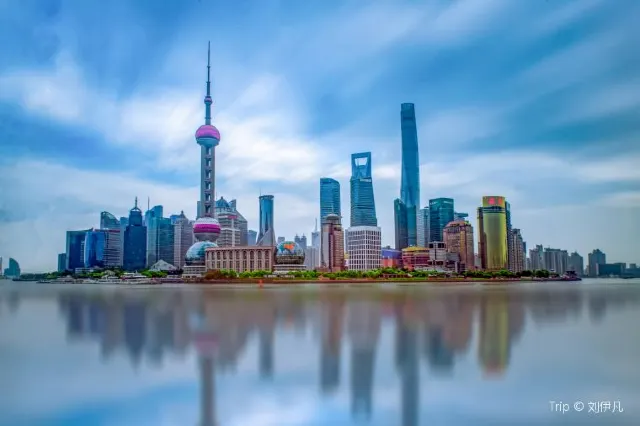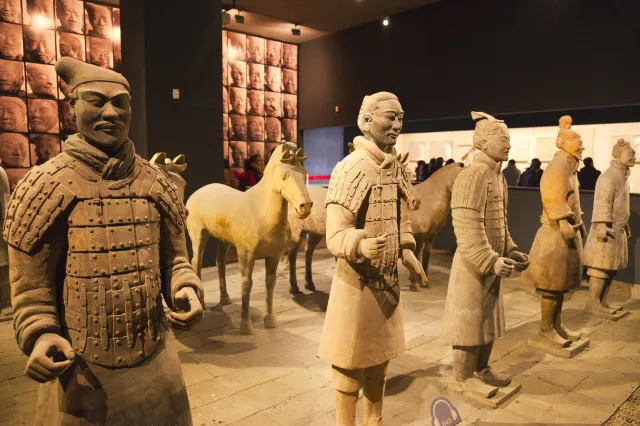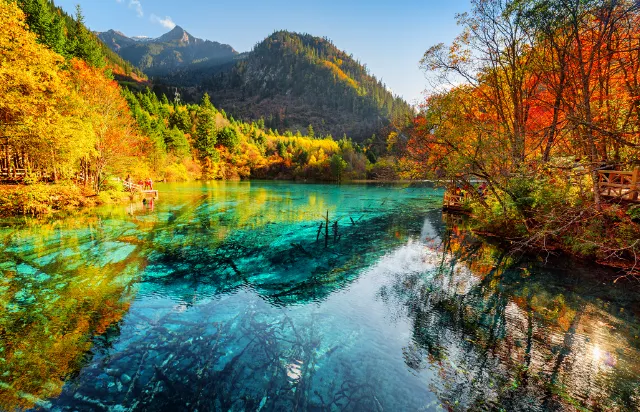The Beauty of Ancient Chinese City Names and What It Means 2024
Catalogue
- Mandarin Chinese
- Understanding Mandarin Place Names
- Beijing
- Shanghai
- Xi'an
- Nanjing
- Shangri-La
- Zhangjiajie
- Heilongjiang Province
- Qinghai Province
- Jiuzhai Valley National Park
- Dunhuang
Show More
Mandarin Chinese has a reputation among Western audiences as one of the world's most difficult languages. Mandarin’s complex, character-based writing system coupled with its tonal vocal structure make it vastly different from the Indo-European languages used throughout Europe, North America, and Australasia. The intrepid linguaphile who sets out to learn Mandarin is at once frustrated and intensely rewarded. In this blog post, we’re taking a closer look at Mandarin place names. What do the Mandarin names of various locations and attractions in China say about them? What’s lost when we translate those names into an English phonetic equivalent? The answers to these questions reveal fascinating things about Mandarin Chinese. They also provide non-Mandarin speakers with a richer appreciation for the wonders to be found when traveling in China. Come along as we explore places with fascinating Chinese language names.

Mandarin is by far the most widely-spoken language in the so-called Sinitic branch, which includes several dialects and subdialects used throughout much of Mainland China, Hong Kong, Macau, and Taiwan. Cantonese is another example of a Sinitic language and likely the second most well-known to Western audiences. In terms of sheer numbers, however, no Sinitic language comes close to Mandarin, which is the native to upwards of 850,000,000 people! Mandarin is the primary language across the bulk of contemporary Mainland China, stretching from the country’s border with the Russian Far East all the way to the borders with Central Asia in the far west and the border with Vietnam in the far south. Across this vast geography, numerous local language varieties developed over many centuries. Some of these are not mutually intelligible. In an effort to promote one single variant for the entire population, the official language of the People’s Republic of China is the so-called Standard Mandarin, whose pronunciation is based on the dialect native to Beijing.
Place names in Mandarin often denote a sense of location with respect to some geographic or geologic features. For example, the word “China” in Mandarin is Zhong·guo (中国). “Zhong” meaning “middle” and “guo” meaning “country” or “nation.” China is thus the Middle Country or historically, the Middle Kingdom. A quick glance at a map of Asia demonstrates a certain logic to this notion. Sandwiched between vast stretches of Siberian tundra to the north, desolate deserts to the west, and seemingly endless oceans to the south and east, China quite reasonably seems to sit in the middle of all of it. Descriptive significance is another common trait in Mandarin place names. The Mandarin word “America” is Mei·guo (美国), the “beautiful country.” Anyone who’s traveled extensively in the US could hardly disagree with such a description. To better appreciate Mandarin place names, let’s take a quick trip around China and explore some more fascinating examples.

China’s capital has long played a pivotal role in the country’s history. From the magnificence of the Forbidden City to the Great Wall on its northern outskirts, Beijing has witnessed some of the most important events in Chinese history. The city’s name is in fact quite simple, Bei·jing (北京) means simply “Northern Capital.” The lands comprising contemporary Beijing changed hands several times during the early dynastic period. For our purposes, we can consider the Yongle Emperor’s decision in 1403 during the Ming dynasty (1368 – 1644) to establish a new imperial capital as the moment when the city’s name becomes more or less fixed. Today, the traces of this long history are visible next to glittering skyscrapers and posh residential buildings. As it was during the Ming era, Beijing’s defining element remains the former imperial palace commonly referred to as the Forbidden City. Constructed at the direction of the Yongle Emperor, the Forbidden City served as the ceremonial and political epicenter of China for close to 500 years. It is known today in Mandarin as Gu·gong (故宫), the “former imperial palace” and the entire city of Beijing essentially radiates out from the palace grounds. Interestingly too, the center of power in contemporary China is literally right next to the Forbidden City in a compound called Zhong·nan·hai (中南海), literally the “Central and Southern Seas.” This is the principal headquarters for the Communist Party of China.

China’s largest city, Shanghai is also the country’s commercial and financial capital. Dubbed the “Paris of the East,” Shanghai garnered a reputation for noir and intrigue in the 1920s and ‘30s. The image of Art Deco buildings, gangsters with tommy guns, and cabaret never completely faded either. In the long sweep of Chinese history, Shanghai is a comparatively new development. Rising to prominence mostly in the mid-19th century as a trading port under the control of European powers, Shanghai now rivals Beijing in terms of importance. In Mandarin, Shang·hai (上海) means literally “upon the sea.” It’s a fitting description considering the Port of Shanghai is the now world’s busiest container port and the place from which China’s vast network of inland factories export their wares to the rest of the world. Visitors to Shanghai can see the stately architecture along the city’s famous Bund and snap photos of the glittering skyscrapers doting the skyline just across the Huangpu River. Outside the financial district, Shanghai displays its softer, more historic side. Long boulevards lined with French Plane trees shade European-style villas as people from all walks of life enjoy simple pleasures in Former French Concession. Here, a constantly evolving mix of cafes, small stores, art galleries, and residential units predominate. The famed arts and crafts enclave known as Tianzifang is a favorite among visitors and one of the best places to see the contrasts powering modern China.

Prior to Beijing’s ascendance, the primary seat of power in China was in Xi’an. Meaning “Western Peace” in Mandarin, Xi’an (西安) long bore the historical name of Chang’an (长安) or “Perpetual Peace.” Xi’an is famous today for the fabled Terracotta Warriors. Known in Mandarin as Bing·ma·yong (兵马俑), they are literally “warriors and horses buried with the dead.” The Terracotta Army is part of the massive Mausoleum of the First Qin Emperor. You will want to budget a least a day to visit the mausoleum complex, which is a little ways outside the city. In downtown Xi’an, be sure to walk along the famous old city walls and visit Daming Palace National Heritage Park. In the evening stroll the city’s historic Muslim Quarter, home to many from China’s minority Hui ethnic group. Enjoy the fabulous noodles, breads, and soups on offer before wandering past the iconic Drum and Bell Towers, which are simply spectacular at night. A fair recommendation is to allow yourself three days in Xi’an. Bonus: budget an extra day for trip to nearby Hua·shan (华山). The “splendid mountain” is one of China’s so-called “Five Great Mountains.”

Careful readers might be able to guess the Mandarin meaning of Nan·jing (南京). Whereas Beijing is the “Northern Capital,” Nanjing is quite literally the “Southern Capital.” For centuries, Nanjing was the most important city in Southeast China, playing a far more significant role than Shanghai. Today, it remains a large and vibrant metropolis with a wealth of great attractions. These include the mausoleum of the Hongwu Emperor, who founded the Ming dynasty in 1368. There is also the Sun Yat-sen Mausoleum. Sun Yat-sen played a pivotal role in modern Chinese history, helping to overthrow the last imperial Qing dynasty and establish the Republic of China in 1911. He is widely regarded as the “Father of Modern China.” The nationalist government Sun Yat-sen helped found was based in Nanjing from 1927 to 1949. Visitors can tour the Presidential Palace of Nanjing and see the former presidential and vice-presidential offices. Be sure to also walk along the Qinhai River and visit the beautiful Confucius Temple there.

Long synonymous with paradise, Shangri-La first entered Western imagination in 1933 when Frank Hilton penned the novel Lost Horizon. Hilton’s vivid description of a fictional land inspired generations of travelers, particular after the 1937 screen adaptation from legendary director Frank Capra. The real Shangri-La City is found in remote Yunnan Province near the border with Myanmar. Its name in Mandarin is Xiang·ge·li·la (香格里拉) and, interestingly, this is one instance where the transliteration goes in the opposite direction. The Mandarin name is an attempt to mimic the English word. In common parlance, the name evokes the same notions of “heaven” or “paradise.” As a real-life destination, it’s every bit as spectacular as you could imagine. Lush grasslands stretch clear to the horizon and fill with wildflowers in the spring and summer. Fresh water streams run down from the Himalayas. The magnificent parallel gorges created by the Hengduan Mountains contain entire ecosystems of diverse flora and fauna. If there were a Garden of Eden, one would not be surprised if it looked like Shangri-La.

If natural landscapes are your thing, Zhangjiajie makes a strong case as one of China’s best destinations. The origin of its name is somewhat unclear; however, the most literal interpretation of Zhang·jia·jie (张家界) is “Zhang family homeland.” Zhang being a very common surname in Mandarin. Tucked into northwest Hunan Province, parts of the Zhangjiajie National Forest Park served as inspiration for the fictional Hallelujah Mountains in the 2009 blockbuster film Avatar. Allot yourself at least one full day for the Forest Park, a massive area set within the larger Wulingyuan Scenic Area, a UNESCO World Heritage Site. Explore the valley and ride the world’s tallest outdoor elevator up for a view from the canyon rim. Spend a second day exploring the famed Tianmen Mountain with its long ascending staircase and natural stone arch. Tian·men·shan (天门山) means literally “Heaven’s Gate Mountain.” This is a beautiful attraction with lots of pathways, gorgeous views, and a temple complex to explore. Zhangjiajie has a developed tourist infrastructure with plenty of accommodations. You can easily visit the parks and return to town for dining and other activities.

Heilongjiang is China’s northernmost province, sharing a long border with Russia. Much of the border is demarcated by the Hei·long·jiang (黑龙江), the “Black Dragon River.” This is a wild and remote place forced to endure bitterly harsh winters despite being at the same latitude as Southern Germany. Fierce winds from Siberia drape the lands in ice and residents have had to develop a hearty tolerance for cold. In the provincial capital Harbin, you’ll find unmistakable Russian architectural influences. The most prominent of these being the onion dome on Saint Sophia Cathedral. The former Russian Orthodox Church is now a museum. Harbin is best known throughout China for its enormous Ice and Snow Sculpture Festival. Held each year in the thick of the Siberian winter, the festival is the largest of its kind in the world and attracts visitors from around the country. Enormous blocks of solid ice are hauled from the Songhua River and brought to the Ice and Snow World, a river island just across from Central Harbin. Expert sculptors spend many hours carving elaborate and life-sized forms, many of which are lit at night in spectacular colors. For those brave enough to face cold, the Ice and Snow Sculpture Festival is an unforgettable experience.

China’s western provinces are vast spaces where grasslands give way to inhospitable deserts. Mountains rise up from the Tibetan plateau and are dotted with beautiful monastery towns. Qing·hai (青海) is China’s fourth-largest province by area. Its Mandarin name translates to “Blue Sea,” a reference to Qinghai Lake, the province’s most famous natural attraction. China’s largest lake is a favored summertime destination for cyclists and motorists who enjoy circumnavigating the lake and camping along the way. Not far from Qinghai Lake is Chaka Salt Lake, a smaller body of water and current salt mining operation. Visitors can wade into the lake using special protective boots and enjoy its highly reflective, almost mirror-like surface. Both attractions are relatively easy to reach from the provincial capital, Xining. Historically, these areas were part of Greater Tibet. Today, the Kumbum Monastery in Xining attracts visitors with its intricate designs and series of stupas. Dongguan Mosque is one of the largest in China and dates back to the Qing dynasty period. Its distinctive dome and minarets stand out against the neighboring buildings. At night, enjoy a stroll by the Nanchuan River where you will find numerous parks and green space walking paths.

Tucked into Northwest Sichuan Province near the border with Gansu Province is Jiuzhai Valley. In Mandarin, Jiu·zhai·gou (九寨沟) translates as the “Nine Settlements Valley” and refers to the historic Tibetan settlements strung along a scenic valley cut into the Min Mountains. Remote and for centuries barely accessible, the lands here remained free from extensive human development. In 1992, UNESCO added Jiuzhai Valley to its list of World Heritage Sites and also declared it a World Biosphere Reserve in 1997. Hearty travelers who venture here are rewarded with stunning natural beauty in the form of pristine mountain lakes, streams, dense forests, and snow-capped peaks. Modern roadways make the journey today a relatively simple matter as compared to say 20 years ago. Those inclined to make the trip would do well to set out from the provincial capital Chengdu. Visit the Chengdu Research Base of Giant Panda Breeding, one of the world’s foremost research and conservation organizations dedicated to the Giant Panda. Make sure as well to get your fill of Sichuan cuisine. With a reputation for spiciness, Sichuan food has become one of China’s most ubiquitous exports. Few things are better than getting it direct from the source, however.

Dunhuang, in far Western Gansu Province, is a historic settlement located along the ancient Silk Road trading routes to Central Asia. Perched on the edge of the Gobi desert, it’s a world away from the lush green lands found in China’s coastal provinces. Today, Dunhuang attracts visitors to the famous Mogao Caves, a vast complex cut into the soft rock hills that contains some of the finest Buddhist art produced during the first millennium CE. You will want to budget a full day given the time it takes to get to the site and through the guided tour. Tickets are required and only a small portion of the caves is open any particular time. Most hotels can arrange transportation and tickets ahead of time. You will want to take advantage of this as the number of daily visitors is limited in order to preserve the delicate art works. Allow yourself another day to visit the famous Ming·sha·shan (鸣沙山), the “Singing Sands Mountain.” This is a beautiful expanse where you can hike massive sand dunes and take a camel ride. It’s as if the ancient Silk Road was still there.
Countless other fascinating names are found throughout China. Knowing the linguistic subtitles communicated in particular place names adds a level of richness to any trip. As a land of great beauty, one could spend a lifetime exploring China and feel as if they barely know the place. With traveling still somewhat difficult due to the COVID-19 pandemic, now just might be the perfect time for you to brush up on a little Mandarinin preparation for your great adventures to come.
Trending Travelogues
Popular Trip Moments
Popular Travel Types
Popular Attractions
Popular Ranked Lists
Popular Destinations
Recommended Attractions at Popular Destinations













Site Operator: Trip.com Travel Singapore Pte. Ltd.







